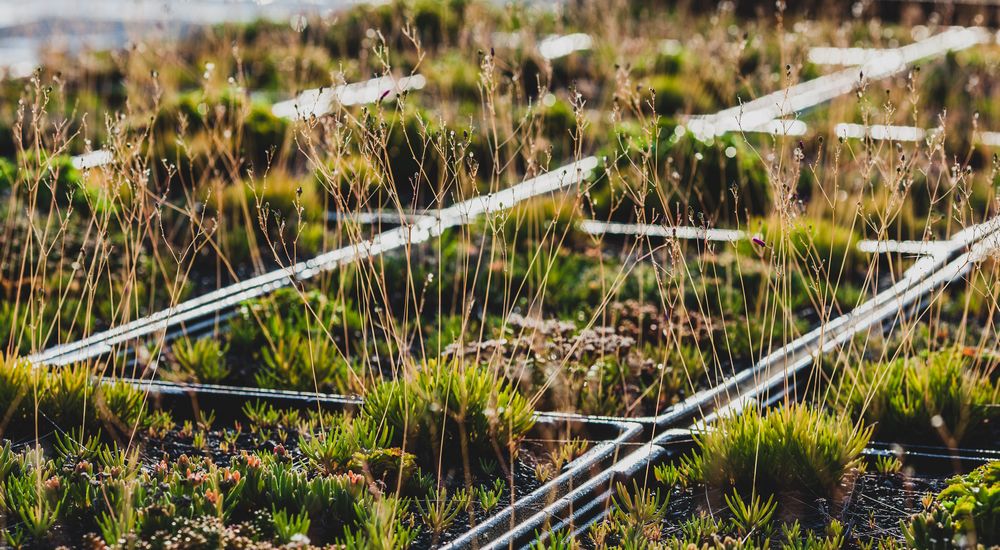Four takeaways on the characteristics of green roofs
The characteristics were analyzed across 36 green roofs in a scientific study code-named GROOVES (Green Roofs Verified Ecosystem Services).

Do green roofs really contribute to nature in the city? Between 2017 and 2019, a scientific study code-named GROOVES (Green Roofs Verified Ecosystem Services) was conducted in the Île-de-France region (Greater Paris and its countryside) to tackle this question. The characteristics were analyzed across 36 green roofs—extensive, intensive, semi-intensive, or wild—on disparate buildings of all heights. The aim? To achieve an understanding that can guide city halls and landscapers who are uncertain how to plant green roofs for optimum performance.

1. Biodiversity invites itself onto green roofs
Rooftop fauna and flora were comprehensively studied to determine the impact of the green roof as a natural life space. It turns out that on average, these roofs play host to a botanical diversity similar to that found in uncultivated land and city parks.
As regards richness in spontaneous vegetation, along with hover flies and wild bees, the building height has a positive effect up to about 10 meters (35 feet - three stories). Spontaneous vegetation alone accounts for 70% of the plant life catalogued, across 400 species. The most common species recorded were:
- Sedum album
- Sedum hispanicum,
- Sedum kamtschaticum
- Vulpia myuros
Certain rare or endangered species were even observed (for example Ornithopus compressus and Ornithopus pinnatus), reinforcing the diversification aspect of green roofs.
The study also highlights a great diversity of invertebrates comprising 611 species. Some can be considered “roofophiles”, others “roofophobes”, with an especially large presence of:
- hemiptera (true bugs)
- hymenoptera
- spiders
- coleoptera
The study observes a significant drop in diversity from the most populated roofs (107 species) to the least populated (20 species). The advantage goes to semi-intensive and intensive green roofs, which also attract a higher number of pollinating insects.
Why is protecting biodiversity the new guideline?
Green roof mini-glossary
Extensive green roof: thin substrate depths up to 10 cm (4 inches), with minimal upkeep and no watering.
Semi-intensive green roof: around 20 cm (8 inches) of substrate, with moderate upkeep and some watering.
Intensive green roof: around 30 cm (12 inches) of substrate. This is the familiar “roof garden”, accessible to users and often used as a vegetable patch.
Wild green roof: substrate left unsown and unplanted, favoring the emergence of spontaneous biodiversity.
2. Substrates with remarkable properties
To determine the soil composition of green roofs, the study defined three categories of substrate commonly used therein (agricultural, mixed, mineral) and compared these with French “RMQS” soil benchmarks. The results were astounding:
- organic carbon content and pH are significantly higher
- the physico-chemical characteristics of green roofs are very special
- the microbial biomass is more than double that of the reference soils
- the organic matter decomposes quite slowly
This last point has a positive impact on floristic affluence. The affluence, however, shows no further increase at substrate depths of more than 25 cm (10 inches), although pollinator diversity continues to rise. The study shows that 30 cm (12-inch) substrates containing at least 10% clay and 60% sand are more likely to favor the implantation of varied flora.
3. High variation in water retention capacity among substrates
In the event of heavy rain, green roofs are nowhere near uniform in performance. The study detected that the least absorbent roofs (mineral substrate, 3.5 cm (1.5 inch) depth) have a retention of 6 liters per square meter (0.15 gallons per square foot) compared with 532 liters per square meter (13 gallons per square foot) for the most absorbent (agricultural substrate, 100 cm (40-inch) depth).
To maximize water retention capacity, roofs composed of agricultural and mixed substrates hold the advantage, according to the study. More exactly, the substrate on a green roof must be between 10 and 30 cm (4 and 12 inches) deep for reasonable performance, with a theoretical depth of 25 cm (10 inches) above which water retention capacity increases dramatically.
Green roofs could therefore expand the city’s toolbox for managing surface rainwater run-off as long as the nature and thickness of the substrate are wisely chosen.
4. Cooling effect very reliant on water availability
The GROOVES study, using an evapotranspiration chamber; observed that the cooling performance of a given roof can be six times as great with well-developed vegetation. Maximum daily evapotranspiration nonetheless exhibits wild variation from one type of roof to another, with the best performance 28 times that of the worst. Once again, the substrate depth and the type of vegetation have a big impact when it comes to the ability of a green roof to provide local cooling.
There is, however, a fly in the ointment: poor availability of water can deplete the performance of green roofs, including intensive roofs. Planting a roof offers only limited effectiveness in the event of a heat wave following a dry spell and must therefore be considered a complementary practice to more widespread revegetation.
Given their characteristics, green roofs are no match for other urban green spaces and cannot address environmental issues on their own. They do however offer genuine advantages in favor of biodiversity, rainwater capture, and to a lesser extent, combatting urban overheating. First and foremost, before pondering on ways to plant a roof, objectives must be set to enable the establishment of design guidelines.
© Photo credit: HBPhoto / Adobe Stock



